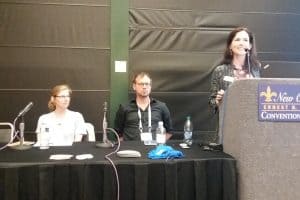
At the “Library and Information Technology Association (LITA) Top Technology Trends” panel, held Sunday, June 25 at the ALA Annual Conference and Exhibition in New Orleans, experts from across the library field discussed technology that will affect the profession in the coming years.
Independent technology consultant Marshall Breeding moderated the discussion, which focused on upcoming technological shifts such as:
Quantum Computing
Jason Bengtson, assistant director of library IT services at Kansas State University Libraries, kicked things off by explaining quantum computing. While traditional, digital computers use bits (which store a 1 or 0), a quantum computer uses qubits, which are capable of storing much more information. This technology is in experimental stages, but Bengston predicts that once we reach “quantum supremacy”—the point at which quantum computers can outperform digital computers—there will be severe consequences for the encryption methods on which libraries rely today. Because quantum computers will be able to perform calculations exponentially faster than digital computers, public key encryption in particular will become vulnerable to brute-force hacks.
Psychometrics
Justin De La Cruz, unit head of e-learning technology at Atlanta University Center’s Robert W. Woodruff Library, spoke about psychometrics. The deep data people provide online has been used to create “hyper-evolved metrics,” he explained, with a level of detail that was not possible before, and that can be used to influence and manipulate individual choices.
He highlighted three items on which libraries should focus:
- Planning and executing the gathering of data and being transparent about what is being collected and how it’s being used (including where vendors and other third parties are concerned).
- Thinking about what data is “leaking out” through trackers that are already tied to users through their devices when they are inside the library, and also from third-party vendors and web services on which the library relies.
- Knowing where to draw the line on collecting user data to minimize the chances of compromising user privacy.
Embedded Digital Libraries
Wider availability of digital content services and services can open avenues to expand the library’s mission. “In the past, public libraries had little effect within small footprints,” said Laura Cole, director of BiblioTech, but new digital technologies will help libraries meet the needs of marginalized populations in new ways. Cole suggested that embedding digital libraries within public housing can help libraries move their mission forward. Having these small-footprint outreach centers close to vulnerable populations could also impact public health. “One of the things we’re looking at is how to use our very small branch libraries as a public health portal,” Cole said. “People can come in, communicate with physicians, and maintain private records.”
Death of Transparency
“We can’t tell whether search results are neutral,” said Marydee Ojala, editor-in-chief of Online Searcher: Information Discovery, Technology, Strategies. Most mainstream search engine results are governed by proprietary algorithms that companies refuse to share with the public. This opacity about why a particular piece of information is provided, when, and to whom, is what Ojala defines as the “death of transparency.”
“When we’re teaching information literacy, we need to recognize that the death of transparency will affect the answers we’re getting,” she said. “We’re not used to thinking of information as fluid,” but users will need to learn to shift their thinking to accommodate this fact.
There’s also a trend toward false information—not just what’s labeled as “fake news,” but fraudulent research, manipulated images, and manipulated video “deep fakes”—that make it very difficult to verify information.
Next Generation Learning Management Systems
Reina Williams, reference librarian and education coordinator at the Library of Rush University Medical Center in Chicago, deals with issues in her university’s learning management systems (LMS) every day. She urges those who are updating systems to make sure the organizational and pedagogical problems in the current systems aren’t duplicated in the new platforms, and that instructors have the tools they need to organize content in a way students can learn from. The next generations of LMS will move away from structured design, she noted, giving students free space to build their own sites and blogs as they progress through the learning process.
A list of these and other upcoming tech trends is hosted online by LITA.


